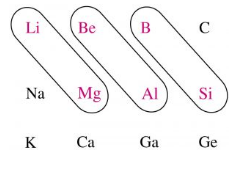
What are bridge elements?
Answer
418.8k+ views
1 likes
Hint :Bridge elements are those elements which show the diagonal relationship with the element of the neighboring period. Period 2 elements are referred to as bridge elements. For example,
Complete Step By Step Answer:
Bridge elements are those elements which show the diagonal relationship with the element of neighboring period. Diagonal relationship describes the similarity in certain properties between two elements which placed diagonally when we move from left to right in two neighbouring periods. These properties include comparable atomic size, the polarization of atoms, electronegativity and so on. The elements which show diagonal relationship are illustrated in the following diagram.

Period 2 elements are referred to as bridge elements. These are so called because these elements bridge the gap between metals on one side (group 1 and 2) and nonmetals/metalloids on the other side (group 13-18). Therefore, from the above diagram we conclude that Lithium
Additional Information:
Diagonal relationship arises because moving along the period and down the period has opposite effects. For instance, as we move down the group, atomic size increases. In contrast, when we move along the period, atomic size decreases.
Note :
It is important to note that bridge elements are those elements which show the diagonal relationship with the element of the neighboring period. Diagonal relationship describes the similarity in certain properties between two elements which are placed diagonally when we move from left to right in two neighbouring periods. Lithium
Complete Step By Step Answer:
Bridge elements are those elements which show the diagonal relationship with the element of neighboring period. Diagonal relationship describes the similarity in certain properties between two elements which placed diagonally when we move from left to right in two neighbouring periods. These properties include comparable atomic size, the polarization of atoms, electronegativity and so on. The elements which show diagonal relationship are illustrated in the following diagram.

Period 2 elements are referred to as bridge elements. These are so called because these elements bridge the gap between metals on one side (group 1 and 2) and nonmetals/metalloids on the other side (group 13-18). Therefore, from the above diagram we conclude that Lithium
Additional Information:
Diagonal relationship arises because moving along the period and down the period has opposite effects. For instance, as we move down the group, atomic size increases. In contrast, when we move along the period, atomic size decreases.
Note :
It is important to note that bridge elements are those elements which show the diagonal relationship with the element of the neighboring period. Diagonal relationship describes the similarity in certain properties between two elements which are placed diagonally when we move from left to right in two neighbouring periods. Lithium
Latest Vedantu courses for you
Grade 9 | CBSE | SCHOOL | English
Vedantu 9 CBSE Pro Course - (2025-26)
School Full course for CBSE students
₹37,300 per year
Recently Updated Pages
Master Class 9 General Knowledge: Engaging Questions & Answers for Success

Master Class 9 English: Engaging Questions & Answers for Success

Master Class 9 Science: Engaging Questions & Answers for Success

Master Class 9 Social Science: Engaging Questions & Answers for Success

Master Class 9 Maths: Engaging Questions & Answers for Success

Class 9 Question and Answer - Your Ultimate Solutions Guide

Trending doubts
State and prove Bernoullis theorem class 11 physics CBSE

What are Quantum numbers Explain the quantum number class 11 chemistry CBSE

Who built the Grand Trunk Road AChandragupta Maurya class 11 social science CBSE

1 ton equals to A 100 kg B 1000 kg C 10 kg D 10000 class 11 physics CBSE

State the laws of reflection of light

One Metric ton is equal to kg A 10000 B 1000 C 100 class 11 physics CBSE




